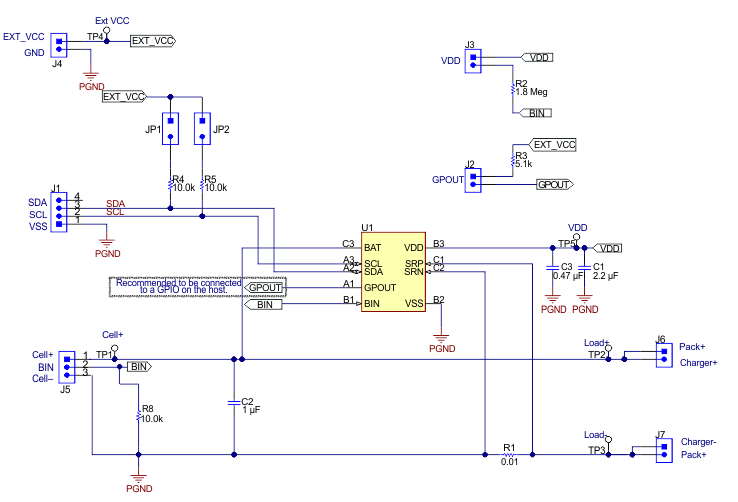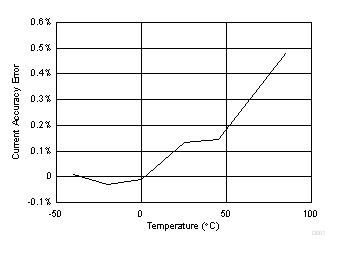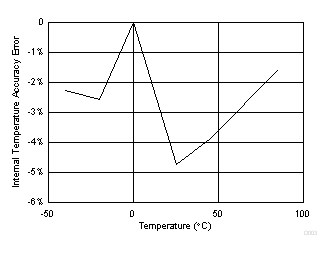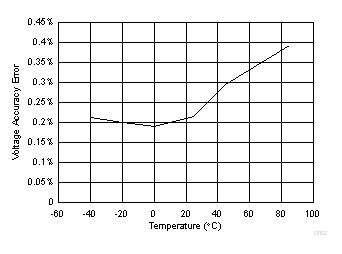ZHCSEX1A March 2016 – April 2016
PRODUCTION DATA.
- 1 特性
- 2 应用
- 3 说明
- 4 修订历史记录
- 5 Pin Configuration and Functions
-
6 Specifications
- 6.1 Absolute Maximum Ratings
- 6.2 ESD Ratings
- 6.3 Recommended Operating Conditions
- 6.4 Thermal Information
- 6.5 Supply Current
- 6.6 Digital Input and Output DC Characteristics
- 6.7 LDO Regulator, Wake-up, and Auto-Shutdown DC Characteristics
- 6.8 LDO Regulator, Wake-up, and Auto-shutdown AC Characteristics
- 6.9 ADC (Temperature and Cell Measurement) Characteristics
- 6.10 Integrating ADC (Coulomb Counter) Characteristics
- 6.11 I2C-Compatible Interface Communication Timing Characteristics
- 6.12 SHUTDOWN and WAKE-UP Timing
- 6.13 Typical Characteristics
- 7 Detailed Description
- 8 Application and Implementation
- 9 Power Supply Recommendation
- 10Layout
- 11器件和文档支持
- 12机械、封装和可订购信息
8 Application and Implementation
NOTE
Information in the following application section is not part of the TI component specification, and TI does not warrant its accuracy or completeness. TI’s customers are responsible for determining suitability of components for their purposes. Customers should validate and test their design implementation to confirm system functionality.
8.1 Application Information
The bq27220 fuel gauge is a microcontroller peripheral that provides system-side or pack-side fuel gauging for single-cell Li-Ion batteries. The device requires minimal configuration and uses One-Time Programmable (OTP) Non-Volatile Memory (NVM). Battery fuel gauging with the fuel gauge requires connections only to PACK+ and PACK– for a removable battery pack or embedded battery circuit. To allow for optimal performance in the end application, special considerations must be taken to ensure minimization of measurement error through proper printed circuit board (PCB) board layout. Such requirements are detailed in Design Requirements.
8.2 Typical Applications
 Figure 10. Typical Application for Pack-Side Using Low-Side Sensing
Figure 10. Typical Application for Pack-Side Using Low-Side Sensing
8.2.1 Design Requirements
As shipped from the Texas Instruments factory, many bq27220 parameters in OTP NVM are left in the unprogrammed state (zero). This partially programmed configuration facilitates customization for each end application. Upon device reset, the contents of OTP are copied to associated volatile RAM-based data memory blocks. For proper operation, all parameters in RAM-based data memory require initialization — either by updating data memory parameters in a lab/evaluation situation or by programming the OTP for customer production. The bq27220 Technical Reference Manual (SLUUBD4) shows the default value and a typically expected value appropriate for most of applications.
8.2.2 Detailed Design Procedure
8.2.2.1 BAT Voltage Sense Input
A ceramic capacitor at the input to the BAT pin is used to bypass AC voltage ripple to ground, greatly reducing its influence on battery voltage measurements. It proves most effective in applications with load profiles that exhibit high-frequency current pulses (that is, cell phones) but is recommended for use in all applications to reduce noise on this sensitive high-impedance measurement node.
8.2.2.2 Integrated LDO Capacitor
The fuel gauge has an integrated LDO with an output on the VDD pin of approximately 1.8 V. A capacitor with a value of at least 2.2 μF should be connected between the VDD pin and VSS. The capacitor must be placed close to the gauge IC and have short traces to both the VDD pin and VSS. This regulator must not be used to provide power for other devices in the system.
8.2.2.3 Sense Resistor Selection
Any variation encountered in the resistance present between the SRP and SRN pins of the fuel gauge will affect the resulting differential voltage, and derived current, that it senses. As such, it is recommended to select a sense resistor with minimal tolerance and temperature coefficient of resistance (TCR) characteristics. The standard recommendation based on the best compromise between performance and price is a 1% tolerance, 50-ppm drift sense resistor with a 1-W power rating.
8.2.3 External Thermistor Support
The fuel gauge temperature sensing circuitry is designed to work with a negative temperature coefficient-type (NTC) thermistor with a characteristic 10-kΩ resistance at room temperature (25°C). The default curve-fitting coefficients configured in the fuel gauge specifically assume a Semitec 103AT type thermistor profile and so that is the default recommendation for thermistor selection purposes. Moving to a separate thermistor resistance profile (for example, JT-2 or others) requires an update to the default thermistor coefficients, which can be modified in RAM to ensure highest accuracy temperature measurement performance.
8.2.4 Application Curves
 Figure 11. Current Accuracy Error vs. Temperature
Figure 11. Current Accuracy Error vs. Temperature
 Figure 13. Internal Temperature Accuracy Error vs. Temperature
Figure 13. Internal Temperature Accuracy Error vs. Temperature
 Figure 12. Voltage Accuracy Error vs. Temperature
Figure 12. Voltage Accuracy Error vs. Temperature